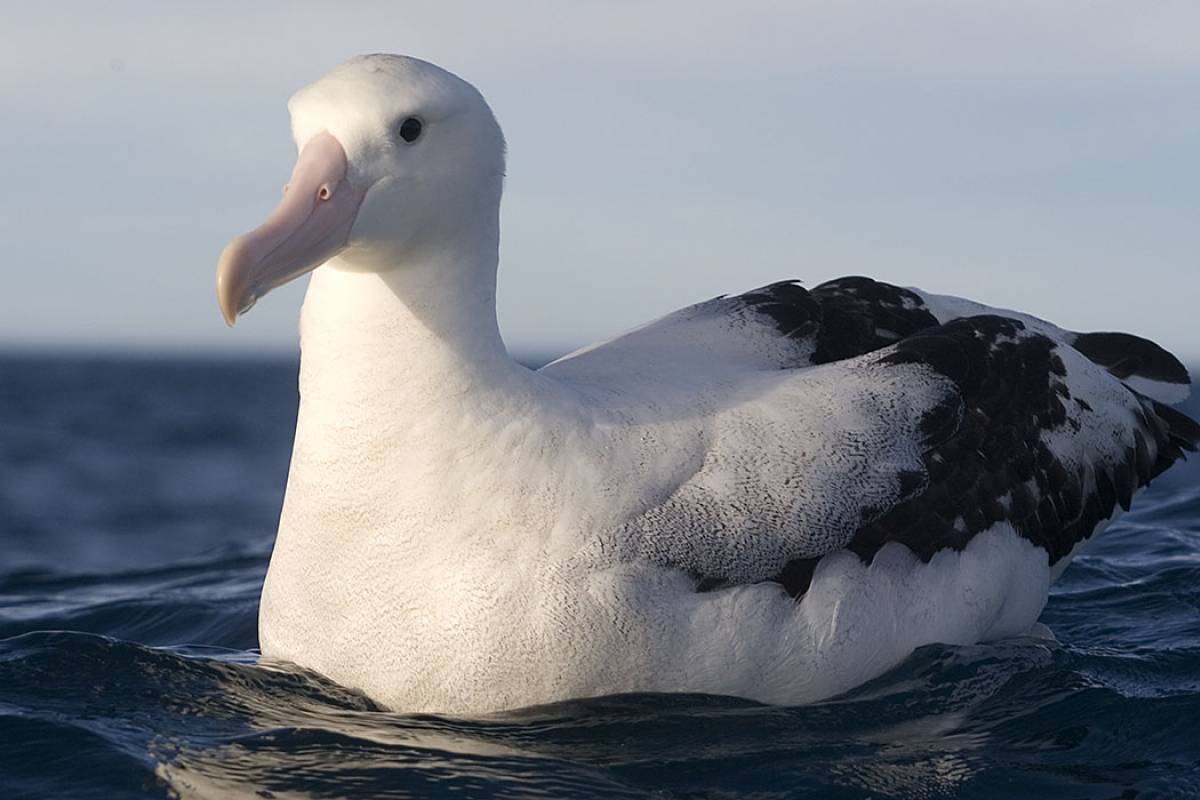These are the main attraction for most people visiting Albatross Encounter: the great albatrosses.
The great albatrosses are seabirds in the genus Diomedea in the albatross family. The genus Diomedea formerly included all albatrosses except the sooty albatrosses, but in 1996 the genus was split, with the mollymawks and the North Pacific albatrosses both being elevated to separate genera. The great albatrosses themselves form two species complexes:
- The wandering albatrosses
- The royal albatrosses
Below are the five varieties of Great Albatross that can be seen off Kaikoura.

Gibson's Wandering Albatross
Gibson’s albatross breed in the Auckland Islands.
In some countries, the Gibson's (Diomedea exulans gibsoni) and the Antipodean albatross (Diomedea exulans antipodensis) are treated as just one species: the Antipodean albatross. But here in New Zealand, we recognise them as two distinct species. The Gibson's albatross is the species you'll see the most of in Kaikoura. Although feeding mainly on squid, Gibson’s are frequent visitors to fishing vessels, with discarded offal and fish processing waste comprising part of their diet. Satellite transmitters have been put on wandering albatross and have shown that birds can travel an incredible 1600km per day. We occasionally see birds with colour bands that have been banded on the Adam’s Island group in the Auckland Islands, some 1000km away.

Snowy Wandering Albatross
The snowy albatross is the largest of the wandering albatross species
The snowy albatross (Diomedea exulans exulans) holds the record in the Guinness Book of Records for having the largest recorded wingspan of any flying bird at 3.6m. Snowy albatross breed around Macquarie, South Georgia, Prince Edward Islands, Crozet and the Kerguelens. They appear much larger and whiter than Gibson’s albatross and you can distinguish them by comparing their size with other species. They are infrequently observed in Kaikoura.

Antipodean Wandering Albatross
Antipodean albatross breed mainly on the Antipodes Islands with a few pairs breeding on the Campbell Islands.
The Antipodean albatross (Diomedea exulans antipodensis) are sometimes confused with the Gibson’s albatross (Diomedea exulans gibsoni) , however Antipodean albatross are smaller in size with a narrow face, darker on the upper wing with a distinctive dark crown. The only definitive way of differentiating between these two species is through the beak length. You can only do that by handling them, so out on the water, it's unlikely you'll know for sure which is which. Despite the Antipodes Islands being closer to Kaikoura than the Auckland Islands, we only occasionally see Antipodean albatross here.

Southern Royal Albatross
Can be seen off the Kaikoura Coast throughout the year.
Southern royal albatross (Diomedea epomophora) are the heaviest species of albatross, weighing up to 10 - 14kg. Young southern royals leave New Zealand waters and fly circumpolar through the Pacific, Indian and Atlantic Oceans, before returning to New Zealand waters to breed as adults when 6-12 years old. They're usually on their own, but sometimes up to three or more birds may be seen around fishing boats. They're mostly an offshore species seen more than three miles off the coast, although they may be seen close to shore during storms. Ninety nine percent of the world’s southern royal albatross population breeds on Campbell Island with the remaining population breeding on the Auckland Islands.

Northern Royal Albatross
Seen throughout the year off the Kaikoura Coast.
Ninety nine percent of the world’s population of northern royal albatross (Diomedea sanfordi) breed on the Chatham Islands. The remaining 1% breed on the world’s only mainland breeding colony at Taiaroa Head, near Dunedin. The northern royal albatross was traditionally harvested by the Moriori and then the Māori. The large flight feathers of the larger albatrosses were collected by Māori for ceremonial purposes and were highly prized. Most of the birds sighted originate from the Chatham Islands rather than from Taiaroa Head, although a few banded birds from Taiaroa Head are seen in Kaikoura on an infrequent basis. One bird banded at the Taiaroa Head colony was known as Grandma and lived to 61 years of age.
Recent Bird Sightings
With around 150 species of birds recorded here so far, Kaikoura is one of New Zealand's top birding destinations. The wonderful array of seabirds just offshore are the jewel in the crown with five varieties of Great Albatross, nine varieties of the smaller Lesser Albatross, seven varieties of Shearwaters, fourteen Petrel varieties, and several other seabird varies such as Shags, Prions, Penguins, Gulls and Terns.